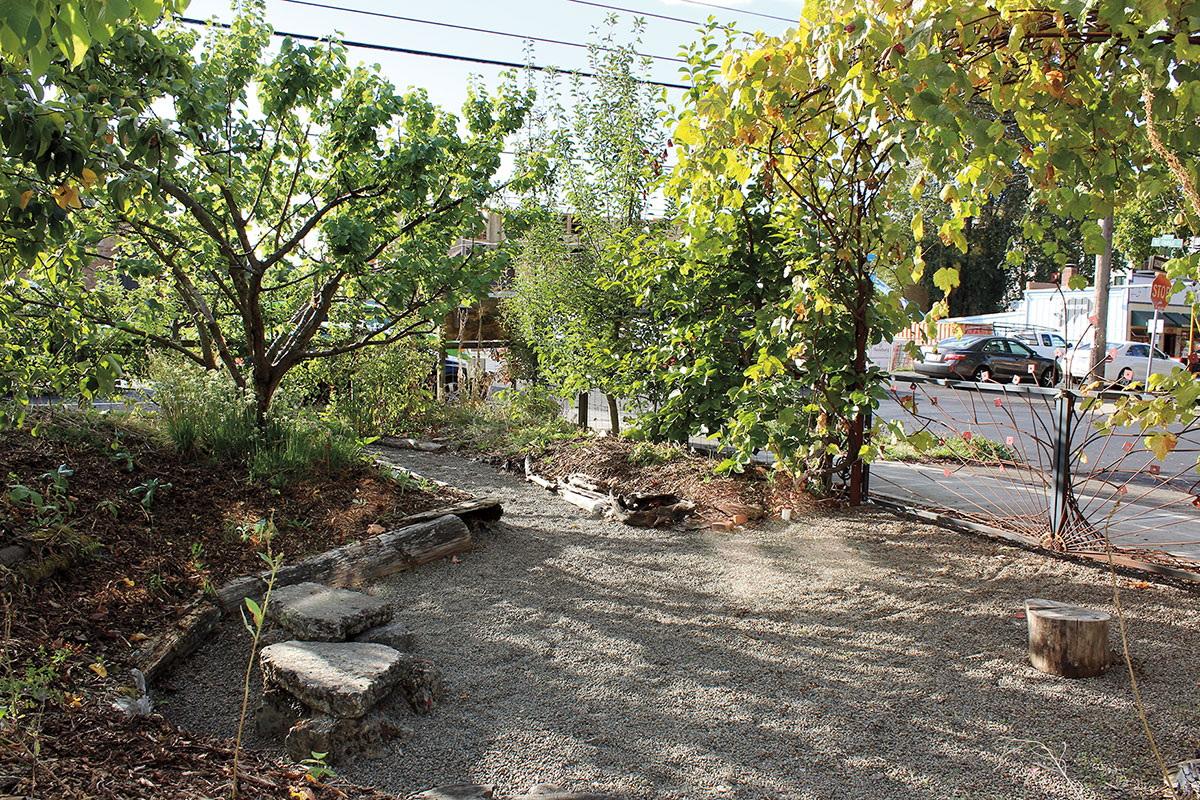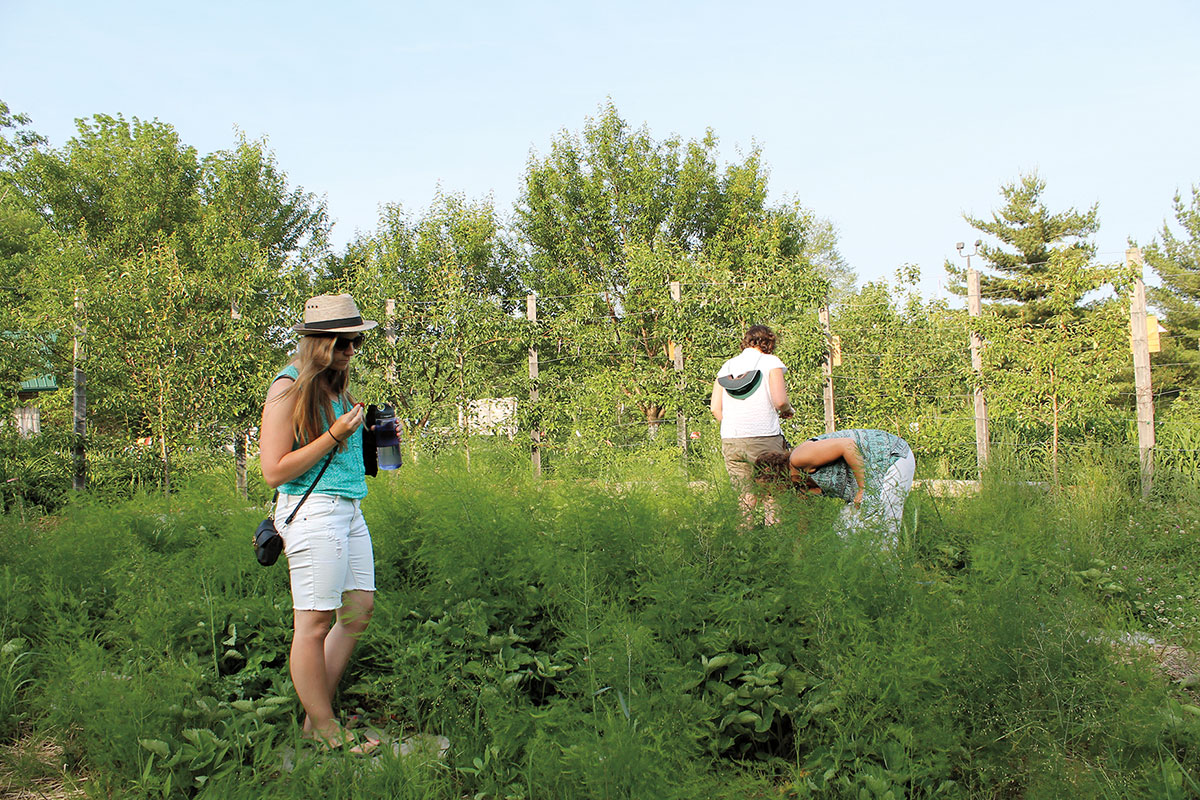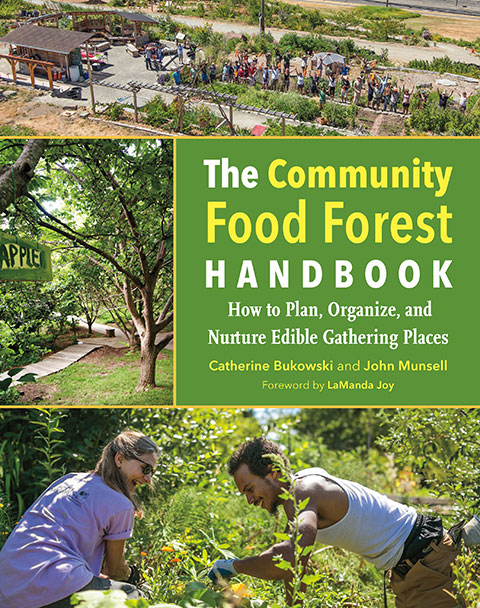Fruit or nut trees like this apple tree at the Bloomington Community Orchard in Bloomington, Ind., are typically planted as canopy species. Shorter plants (shrubby perennials, tall herbs, or flowers) and ground covers are installed below trees or along the periphery of a patch.
This excerpt is adapted from The Community Food Forest Handbook: How to Plan, Organize, and Nurture Edible Gathering Places (Chelsea Green, 2018) and is reprinted with permission from the publisher.
Community food forests are capturing the imagination of people in neighborhoods, towns, and cities across the United States. But what is a community food forest? The definition differs depending on whether the focus is on the concept or the physical space..
An on-the-ground, physical food forest mimics the spatial and functional patterns of a naturally occurring forest ecosystem. Most people think of a forest as a large area, but from a biological standpoint a forest does not have to meet a minimum height or size requirement. Rather, the term food forest signifies a highly integrated community of plants that has various vertical and horizontal plant and root layers that provide edible products.
 At the Fargo Forest Garden in Portland, Ore., mounds of soil replicate forest floor terrain and create microclimates and soil conditions favorable for selected plants. The mounds also help direct water runoff into pathways engineered to channel water to a gravel patio designed with a dry well below to collect water during major storm events.
At the Fargo Forest Garden in Portland, Ore., mounds of soil replicate forest floor terrain and create microclimates and soil conditions favorable for selected plants. The mounds also help direct water runoff into pathways engineered to channel water to a gravel patio designed with a dry well below to collect water during major storm events.
Modeling the structure of a young forest ecosystem in public places is ideal for two reasons. First, planting multiple perennial species in close proximity can sustainably yield food in confined areas, which can help meet the growing global demand for nutritious production. Second, as the vegetation matures, it can create a forested, park-like setting, providing a pleasing natural space where community members can gather. Even if food production in a community food forest decreases, the forest still provides valuable green space in built environments.
Conceptually, to better understand the meaning embedded in the term community food forest, consider each word: forest, food, and community Forests are places, but forests become social spaces through physical, cultural, environmental, and emotional connections. One such connection is food, which can bring people together, but others such as dialogue, wildlife, and recreation are also important. When people connect in forested spaces, they shape their social sense of place, values, and identity and create community.
Societal Shifts
The first contemporary community food forest launched in 1997 in Asheville, N.C. About a decade later a couple of community food forests arose in progressive cities, but it was not until around 2012 that the extensive media coverage of the Beacon Hill Food Forest in Seattle catapulted community food forests into the public eye, and the rate of new projects began to accelerate. As of 2018, more than seventy community food forests exist in public spaces in the United States in communities of all sizes, spanning from the Pacific Northwest to the Deep South.
 The center of the Bloomington Community Orchard in Bloomington, Ind., is covered by a large patch of vegetation where visitors can walk among tall feathery shoots of asparagus and strawberry bushes. This site offers a variety of experience from open areas in full sun to more shaded areas where there are mushroom production experiments.
The center of the Bloomington Community Orchard in Bloomington, Ind., is covered by a large patch of vegetation where visitors can walk among tall feathery shoots of asparagus and strawberry bushes. This site offers a variety of experience from open areas in full sun to more shaded areas where there are mushroom production experiments.
The rise of community food forests correlates with larger changes in social consciousness and dialogue about local food production and access. Green space that provides healthy and fresh food to people and important environmental services to communities are some of the most compelling benefits of food forests. Planning for the Beacon Hill project began in 2009, the same year that First Lady Michelle Obama initiated a national conversation about food production. At that time, dialogue about the need for new food systems and community building was increasing. Reclaiming sovereignty over food production using environmentally dynamic systems to do so has been central to many contemporary community food forest projects.
Community food forests can be found in a variety of places. Churches, universities, and intentional communities have planted food forests on their campuses. They are increasingly found on public property managed by public works agencies or parks and recreation departments. Regardless of where they are located, these projects are open to the public. Volunteers and civic organizations are often involved in their development and oversight. On public grounds, the collaboration and communication between agency employees, project leaders, and volunteers is essential for effective management and community support.
The popularity of food forests reflects a value shift in urban cultural pockets. The message is a desire for public space, where possible, to be ecologically designed with perennial and annual plants that produce food and herbal medicine, enhance nutrition, promote food literacy, and provide a useful and safe place to gather, recreate, and work together. This is all while engaging people in active participation to create the places they want to live in and to voice their opinion through action. By developing these spaces, people are stating that ecologically healthy green spaces and sustainable local food production are valued, especially in the face of urban population growth.
Sustaining Food Forest Communities
Today’s excitement about local food and nutrition can be a powerful motivator that spurs people to try something new like joining a community food forest project. Their positive energy is important, but it needs to be guided. On its own, it is not enough to sustain a community food forest project. Project leaders looking to help shape their community and its collective work can use systems thinking as a framework when designing and implementing a community food forest. A necessary part of this is defining the values associated with local food so as to motivate community members to take part in civic activities. In this way, an array of stakeholders, including nonprofit organizations, academic institutions, local government, and community-based organizations, can help shape their community.
Systems thinking has evolved over time into a holistic and adaptive framework. It lays out a process for pursuing a goal while keeping the relationships between people and their environment at the forefront. Systems thinking helps identify ways to effectively work together as a group of people who want to create change in a community by developing a community food forest. Systems thinkers are better able to see community connections that are not always clear. Thus, they can more effectively find ways to achieve their goals and create the change they seek.
Working effectively with the physical attributes of a site while adequately serving a community in the design and management of a community food forest is no small task. It requires trade-offs between ecological design and meaningful community space. One cannot override the other, and because of this, systems thinking is both helpful and warranted. Food forest leaders must balance plantings and design at a given site with the activities and services people want in that particular place. And they must consider this balance in terms of system equilibrium when everything is calm as well as during times of change.
Today, green space is not just “a little bit of nature” in the cityscape. Rather, it encompasses multifunctional systems that yield lasting payoffs such as leisure, health, and well-being; food production; habitat conservation; watershed management; urban canopy; and social interaction. Community food forests encourage people to think in terms of abundance and inspire neighborhoods to act on their own behalf. They promote a culture of sharing, stewardship, and nature-centered health.

To learn more: Check out The Community Food Forest Handbook, which explores the civic aspects of community food forests, drawing on observations, group meetings, and interviews at over 20 projects across the country and the authors’ experiences creating and managing a food forest.
About the authors: Catherine Bukowski is a PhD candidate in the College of Natural Resources and the Environment at Virginia Tech, where she co-taught an agroforestry and whole-farm-planning course that incorporated permaculture principles. John Munsell is an associate professor and forest management extension specialist at Virginia Tech, where he teaches agroforestry and permaculture.
